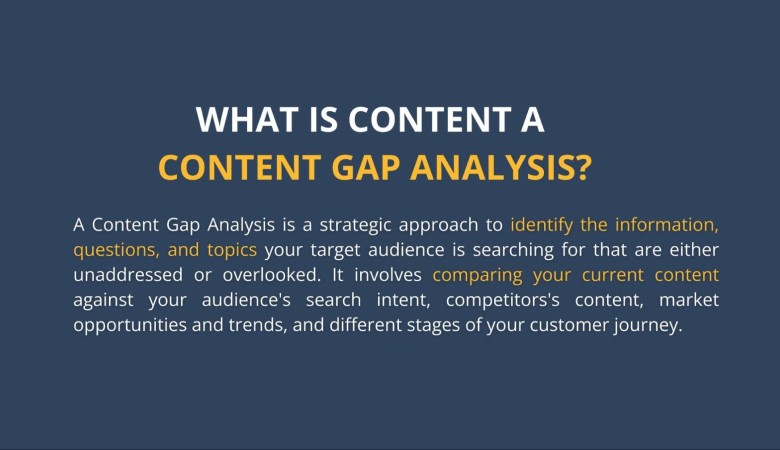How Content Gap Analysis Strengthens Your Marketing Strategy
Content gap analysis is the secret weapon behind the most successful content strategies. It’s what sets apart the brands
that truly stand out from the ones just blending in.
How often do you come across blogs that feel like slight variations of the same idea? The key to winning content marketing isn’t just adding to the noise; it’s finding the gaps no one else is filling.
In this blog, we’ll break down the step-by-step process of content gap analysis and share best practices to help you
create content that resonates and ranks.
What Is a Content Gap Analysis?
Content gap analysis identifies the topics, questions, and information your target audience is searching for but isn’t
adequately covered by your current content. It helps you discover areas where your content strategy is lacking and
pinpoint opportunities to fill those gaps with valuable, relevant information.
The primary goal is to ensure that your content meets your audience’s needs at every stage of their journey. This
involves analyzing your content, comparing it with your competitors’ content, and understanding your audience’s search
intent.
In simpler terms, content gap analysis is all about finding the “gaps” where your content could add more value—whether
by addressing overlooked topics, answering common questions, or covering emerging trends that others haven’t touched on
yet.
By filling these gaps, you enhance your content strategy, boost your search rankings, and position your brand as a
trusted resource in your niche.
What Makes Content Gap Analysis So Important?
There’s often a disconnect between our audience’s needs and our content’s delivery. As marketers, it’s easy to rely on
assumptions about which challenges to address and which topics to cover—but those assumptions can be misleading.
Content gap analysis provides a data-driven approach to understanding what your audience is genuinely searching for. It
helps you move beyond guesswork and create content that addresses their needs and interests directly.
By identifying these gaps, you gain a clear direction for your content roadmap, allowing you to focus on what truly
matters to your audience. Ultimately, it’s not just about producing more content—it’s about producing the right content
that adds value and builds trust.
Potential Benefits of Content Gap Analysis
1. Attracts Ready to Convert, High-Intent Traffic
One of the most powerful outcomes of content gap analysis is attracting high-intent traffic—visitors who are ready to
decide but need that final nudge.
At the bottom of the funnel (BOFU), people are close to converting but often have lingering doubts or questions that no
one else has addressed. By identifying and targeting these gaps, you can create content that directly tackles their
concerns, guiding them confidently toward conversion.
When your content steps in at just the right moment with answers and solutions, it drives traffic and increases your
chances of turning visitors into loyal customers.
2. Enhance Your Search Engine Rankings
Meaningful content that aligns with search intent naturally boosts search engine rankings, giving you a competitive
edge.
For example, during a project with an AdTech company, I discovered that dynamic creative optimization (DCO) was a
relevant yet underexplored topic. Most competitors had touched on it, but their content lacked depth and missed critical
questions like “Does DCO use cookies?” and comparisons like “Programmatic creative vs. dynamic creative optimization.”
I identified these gaps using keyword research tools and created in-depth content around them. The result? Improved
rankings and a steady flow of relevant traffic prove that addressing content gaps can make a real difference.
3. Be the first to address the audience’s pain points
There’s nothing better than being the first to address your audience’s pain points. Content gap analysis helps you spot
unmet needs early on, allowing you to create unique, valuable content before your competitors catch on.
Being the first to cover a trending or underserved topic offers multiple advantages:
- Backlink Opportunities: High-quality, original content often becomes a reference point for
others covering the same topic later, earning you valuable backlinks and boosting your domain authority. - Increased Visibility: With minimal competition, search engines are more likely to reward your
content with top rankings. - Thought Leadership: Leading the conversation on new or niche topics positions your brand as a
trusted expert.
4. Foster Trust and Authority
Content gap analysis isn’t just about filling empty spaces—it’s about creating value where it truly matters by
identifying not only the “what” but also the “why” and “when” behind your audience’s search intent. By doing so, you
position yourself as a reliable source of information.
How to Conduct a Content Gap Analysis
Various ways to perform a content gap analysis depend on your goals and objectives. In this guide, we’ll walk you
through a practical, step-by-step approach to uncovering opportunities and optimizing your content strategy:
Step 1: Identify Where Your Audience Spends Time
One of the most common mistakes businesses make during content gap analysis is diving straight into keyword research
without first understanding where their audience engages.
It’s essential to take a step back and consider where your target audience feels comfortable discussing their
challenges, asking questions, and sharing frustrations. These online spaces are gold mines for uncovering content gaps
and discovering what people genuinely care about.
For instance, platforms like Reddit are particularly insightful for specific industries. In the SEO space, forums like
r/seo and r/bigseo often feature discussions around challenges like handling Google’s Core Updates or demonstrating ROI
to clients. Monitoring these conversations helps identify recurring pain points and underserved or overlooked topics.
Pro Tip: Don’t just listen—engage! If you encounter a question that aligns with your expertise on these
platforms, offer a thoughtful answer. This builds credibility and positions your brand as an authority, even before
users visit your site.
Step 2: Uncover Your Keyword Gaps
The next crucial step in content gap analysis is evaluating your existing keyword strategy. This involves determining
how well your content aligns with the search terms your audience is actively using.
- Benchmark Your Keywords Against Competitors:
Begin by identifying the topics and phrases that your audience frequently searches for. Use powerful keyword
research tools like Google Keyword Planner, SEMRush, or Ahrefs to get insights into high-traffic and
relevant keywords.Analyzing your competitors’ content can reveal keywords they are ranking for that you might be missing. This
comparison helps you pinpoint opportunities to fill gaps and boost your content’s relevance. - Leverage the Missing Keywords Section:
Many keyword research tools feature a “missing keywords” or “keyword gap” section. This part highlights the
keywords your competitors rank for that your content does not address.By paying attention to this section, you can identify valuable search terms that your target audience is
actively using but that your content strategy has overlooked. Tackling these gaps can help improve your
visibility and increase organic traffic. - Capitalize on Weak Keywords such as Low-Hanging Fruit:
While targeting high-volume, competitive keywords are essential, don’t ignore weak keywords—those where
your site already ranks but not on the first page.Focusing on these can provide quick wins with minimal effort. Look for keywords where you rank between positions
10 and 20, and update or expand the related content to push it higher. Optimizing these low-hanging fruits can
significantly enhance your search engine performance.
Step 3: Conduct a Comprehensive Content Audit
Now that you’ve identified your keyword gaps, it’s time to analyze your existing content. A thorough content audit will
help you spot outdated, underperforming, or missing content pieces that need improvement. This ensures your strategy is
driven by data, not assumptions.
- Define Your Goals First:
Every content strategy is unique, so it’s essential to be clear about your goals from the outset. Are you aiming
to increase quality traffic, boost engagement, or drive conversions?For instance, if your primary objective is to optimize Bottom-of-the-Funnel (BOFU) content, your focus should be
on auditing conversion-oriented pages like case studies or product comparisons. On the other hand, if the goal
is to increase traffic, prioritize blog posts and guides that attract organic visits. - Create a Content Inventory:
Start by making a master spreadsheet that lists all your content assets. Include the following:- Blog posts and guides
- Landing pages and service pages
- Resource materials and downloadables
- Product pages and comparison pages
- Document Essential Metadata for Each Asset:
Your spreadsheet should include key information to help you analyze each piece:- URL and publication date
- Primary and secondary keywords
- Content type and format
- Target audience
Tracking this metadata ensures that you understand the context and relevance of each content asset.
- Track Performance Metrics:
For each content piece, record performance metrics to gauge its effectiveness:- Organic traffic and search rankings
- Time on page
- Bounce rates
- Conversion rates
- Backlinks and social shares
You’ll be better positioned to make data-driven improvements by systematically tracking these metrics.
- Categorize Your Content:
Grouping your content helps you understand its purpose and effectiveness:- Stage in Customer Journey: Awareness, consideration, decision
- Business Objective: Lead generation, sales, brand building
- Content Format: Case studies, how-to guides, comparison posts
- Target Audience Persona: Who the content is intended for
This categorization helps pinpoint where content is lacking and where improvements are needed.
- Identify and Flag Critical Areas:
During the audit, highlight the following problem areas:- Duplicate or cannibalized content
- Broken links and technical issues
- Outdated information and statistics
- Missing meta descriptions or titles
Flagging these issues ensures your content remains relevant and optimized for search engines.
- Spot Opportunities for Improvement:
Look for areas where you can upgrade or expand your content:- Repurpose high-performing content into new formats
- Expand thin or underdeveloped content
- Update outdated statistics and information
- Fill content gaps identified during your keyword research
- Analyze, Map, and Strategize:
Now it’s time to put your findings into action:- Import the pain points and keywords identified in previous steps.
- Cross-reference your existing content with these insights.
- Identify missed opportunities or topics your competitors have addressed but haven’t addressed.
- Highlight areas where content upgrades or new content creation are needed.
By mapping your content gaps against audience needs and competitor offerings, you’ll develop a comprehensive
roadmap for content optimization and creation.
Pro Tip: Automate Your Content Gap Analysis
Save time and effort by leveraging AI-powered tools like Rival Flow. This tool automates the content gap analysis
process by comparing your blog posts with the top three ranking SERP pages. Instead of manually identifying gaps, Rival
Flow provides actionable insights, allowing you to focus on strategic improvements.
Step 4: Bridge the Content Gap
Once you’ve laid out your content strategy, it’s time to take decisive action. This stage focuses on revitalizing existing
content and creating new pieces that address the gaps identified earlier.
- Refresh High-Potential Pages:
Start by focusing on pages on the verge of ranking success—typically in positions 5 to 15 on search engine
results pages. The goal is to boost their relevance by:- Improving Readability: Break down complex information and enhance user experience.
- Updating Information: Replace outdated statistics, references, and examples with fresh,
accurate data. - Aligning with User Intent: Make sure the content directly addresses what your audience
is searching for.
A recent Contentoo-HubSpot study shows that refreshing content can significantly increase traffic and
conversions while reducing content production costs by over 80%. - Create New Targeted Content:
When you identify apparent content gaps, seize the opportunity to develop fresh, insightful content that
addresses your audience’s pain points. This could include:- In-Depth Blog Posts: Cover emerging topics that your competitors have overlooked.
- Guides and Tutorials: Provide step-by-step solutions to common challenges.
- Videos and Infographics: Diversify your content formats to cater to different
preferences.
- Collaborate With Your Team:
The most effective content comes from a well-rounded understanding of your customers’ struggles and needs. To
achieve this, actively collaborate with various teams:- Sales and Customer Support: Identify common questions and pain points.
- Product Teams: Gather insights into features or updates that need highlighting.
- Marketing and Outreach: Coordinate content distribution and engagement strategies.
By pooling insights from all departments, you ensure that your content is not only informative but also aligned
with business goals. - Track and Iterate:
After publishing your updated or new content, continuously monitor its performance to determine whether your
strategy is working or needs adjustments.- Performance Metrics to Track:
- Organic traffic
- Engagement rates
- Conversion metrics
- Bounce rates
- Social shares
- Adjust as Needed:
- If content is underperforming, revisit keyword alignment or update with fresh insights.
- If content performs well, consider repurposing it into new formats to reach a wider audience.
- Performance Metrics to Track:
Best Practices for Effective Content Gap Analysis
Now that we’ve covered the step-by-step content gap analysis process let’s explore some practical strategies to elevate your approach. These proven techniques will help you move beyond the basics and make your content impactful.
1. Listen to Your Audience — Even When They’re Not Speaking
Keyword and SEO tools are essential, but they only scratch the surface of understanding your audience’s real needs. To truly connect, you must listen—even when your audience isn’t explicitly voicing their concerns.
Pro Tip: Go beyond product and service reviews. Look out for:
- Recurring questions in live chat support.
- Insights from client calls and customer feedback.
- Discussions on social media and community forums.
Gathering insights from these sources will uncover hidden pain points and topics your content may be missing.
2. Prioritize Search Intent Over Keyword Volume
Chasing high-volume keywords without considering intent often leads to traffic that doesn’t convert. Instead, understand why your audience is searching and align your content to meet those needs.
Segmentation Tip: Categorize keywords based on their intent:
- Informational: Answer questions and provide insights.
- Navigational: Guide users to specific pages or services.
- Transactional: Target users ready to take action or make a purchase.
Focusing on intent rather than volume will attract more qualified leads and increase conversion rates.
3. Embrace Niche Topics to Stand Out
Instead of going after broad, competitive keywords, find your unique angle by diving into niche topics. This strategy helps you rank faster and builds a dedicated audience that values your specialized insights.
Why It Works:
- Less competition: It is easier to rank for specific, targeted queries.
- Audience loyalty: Attracts readers genuinely interested in your niche.
- Higher engagement: Relevant, targeted content resonates better.
4. Go Beyond Exact Keyword Matches
Many businesses make the mistake of focusing solely on exact keyword matches. However, users search in diverse ways that may not always align with your chosen phrases.
Actionable Tip: Recognize subtle variations in user queries by considering the following:
- Keyword alternatives and synonyms.
- Shifts in user intent based on phrasing.
- Common misspellings or regional differences.
You can expand your reach and boost your search visibility by accommodating these variations.
Partner with our Digital Marketing Agency
Ask Engage Coders to create a comprehensive and inclusive digital marketing plan that takes your business to new heights.
Bridge Gaps, Build Connections: Mastering Content Gap Analysis
Content gap analysis isn’t just a routine marketing task — it’s your roadmap to creating content that truly resonates with your audience. You build lasting connections beyond algorithms by understanding their needs and addressing their pain points.
Now that you know how to conduct a content gap analysis, remember to focus on the fundamentals. Stay tuned to what your audience wants and meet them where they are.
Ultimately, it’s not just about closing gaps for search engines — it’s about building connections that matter. Let me know if you’d like more tips on optimizing your content strategy!












